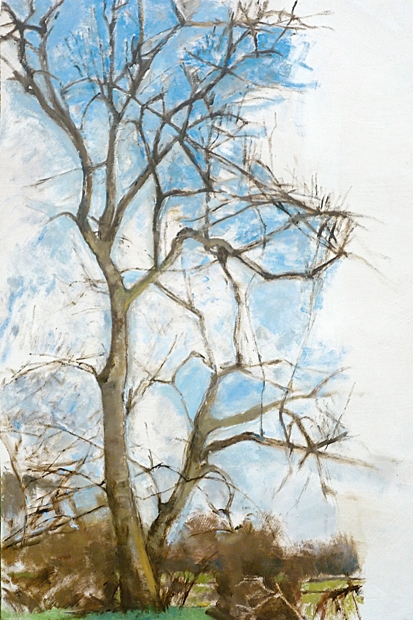‘If I see something I like I wish to tell someone else; this… is why I paint.’ Patrick George is 91, still painting ‘some of the best work he’s ever done’, in Andrew Lambirth’s view. ‘His principal aim is to point out, to those of us less well-trained to observe, how marvellous the appearance of things is, and he does this through exquisite landscapes, figure and still-life paintings, of unassuming but stringent beauty.’
After four years in the Navy (he commanded a landing craft in the D-Day landings) George went to Camberwell art school where he imbibed the strict measuring technique associated with William Coldstream, which he has continued to use — though not exclusively — throughout his career. He taught at the Slade for 40 years, latterly as its director, but has lived for most of his life ‘a rustic existence’ in Suffolk, in the ordered, ‘working landscape’ that he has made his principal subject — ‘doing all the things that go with this kind of rural life. I like good food. I like good claret and I like whisky. That’s about it.’
An enviable existence — but painting outside, with the intensity of concentration which George’s method requires, is not without its rigours. The pictures often take years to paint, ‘and during their making everything changes…. How to paint the changes of weather and season?’ His solution is to paint ‘the same scene, month after month, incorporating the changing information available, superimposing it on what was already there.’

The quiet, ‘unassuming’ nature of George’s work no doubt accounts for his being overlooked among his noisier contemporaries; but Lambirth argues persuasively that George’s paintings ‘are nearly always more radical than they at first appear’, and that he belongs to the group of innovative artists loosely known as the School of London, which includes Auerbach (a strong supporter of George’s work), Bacon, Kitaj, Freud, Kossoff and Michael Andrews. The results, as Lambirth points out, ‘might easily be horribly clotted or chaotic’, but somehow ‘the bones of the landscape emerge’, its essence; and despite all the ‘heroic grappling between hand and eye’ with the freshness (a phrase used about the work of George’s close friend Euan Uglow), an almost palpable sense of being out of doors is somehow preserved. There are certainly practical difficulties: ‘When snow mixes with oil paint it becomes very odd stuff and sets like concrete.’ Sitting down, a cow might come and lay its head on your knee so you must paint over the top of it. Lawrence Gowing wrote of George that ‘the gentle fanaticism of his method is traditional plein-airism unhinged’.
Lambirth is an admirably self-effacing, knowledgeable and sympathetic critic and it is difficult to see how this long-overdue monograph, its text drawn largely from conversations with the artist and his fellow painters, and full colour throughout, could be bettered. It is about the work — with only the bare bones of biographical information: a single-minded, remarkably coherent, lifetime of painting.






Comments